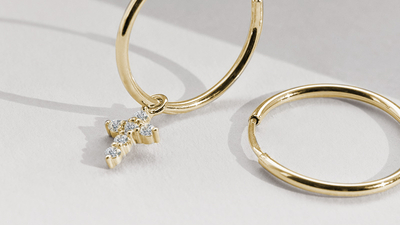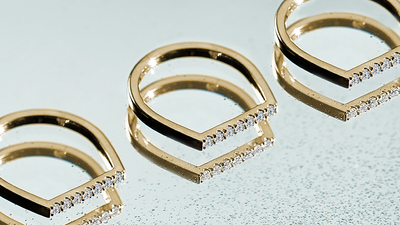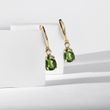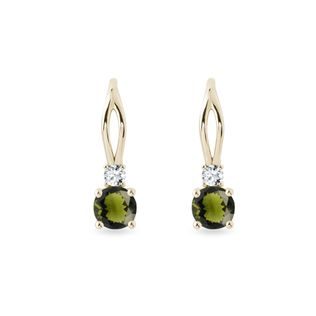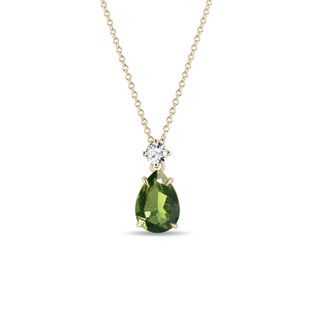Diamond and Moldavite Earrings in Yellow Gold
Original 14k yellow gold earrings that combine imaginative shapes and bright colors. On the fixed part of jewelry is a freely swinging drop-shaped moldavite stone with a height of 10 mm. Above it is a small pure glittering diamond in a round cut. A great gift idea for lovers of traditional Czech gems.
Our earrings are handcrafted at the KLENOTA jewelry studio. We will deliver the jewelry to you in an elegant gift box along with a Certificate of Authenticity. Find out more about the different types of earrings and earring closures in our guide.
Availability: in stock & ready to ship.
| CODE | K0672163 |
| Material |
Yellow Gold fineness 14 karat 585/1000 |
| Gemstone |
Moldavite Origin natural Cut pear width 7.0 mm height 10 mm weight 3.000 ct Diamond Origin natural cut round clarity SI color G diameter 2.5 mm weight 0.12 ct |
| weight | 4.1 g |
Jewelry from the KLENOTA ATELIER
Located in the very heart of the Old Town of Prague, our atelier and workshop draws inspiration from the centuries of local goldsmithing traditions to create timeless yet modern jewelry. Each piece is handcrafted to perfection by our skilled artisans, using only high quality materials from verified sources so you can cherish our jewelry for years to come. Discover the true meaning of elegance with KLENOTA.
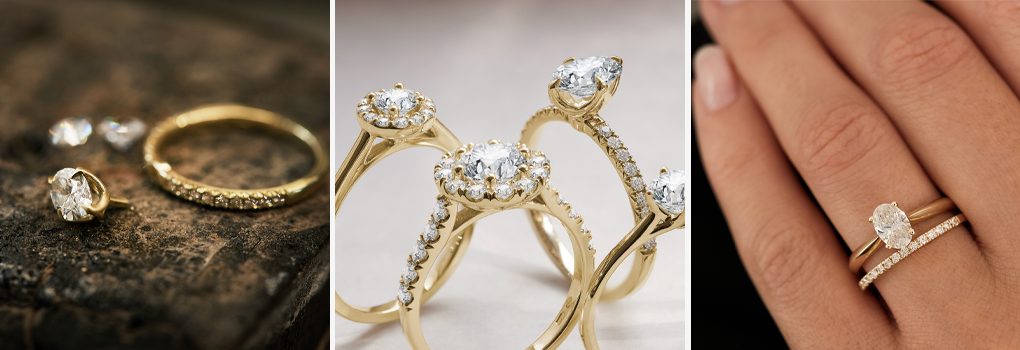
Diamond jewelry
In the process of evaluating and certifying diamonds, they are assessed based on four fundamental parameters which are called the 4Cs: cut, clarity, color, and carat. These four properties then significantly influence the price of a diamond.
CUT: The right cut gives a diamond its radiant luster. The most popular cut is a round one known as the brilliant cut. Diamonds can also be cut into a wide array of “fantasy” cuts which include the marquise, baguette, heart, teardrop, oval, and princess (a three-sided or four-sided cut with sharp corners which is especially popular for engagement rings).
CLARITY: Clarity is determined by the number, size, and distribution of any inclusions (internal impurities) in a diamond:
- IF (Internally Flawless) – clear diamonds without any inclusions,
- VVS 1, VVS 2 (Very Very Slightly Included) – diamonds with very small inclusions,
- VS 1, VS 2 (Very Slightly Included) – diamonds with small inclusions,
- SI 1, SI 2 (Slightly Included) – diamonds with inclusions which can be seen with a magnifying glass,
- I1, I2, I3 (Included), also labeled as “P” in the Czech Republic – diamonds with medium to larger inclusions visible to the naked eye.
COLOR: The color of colorless to yellow diamonds is evaluated based on an international scale:
- D to F – colorless diamonds;
- G to J – near colorless diamonds;
- K to M – diamonds with a touch of yellow;
- N to Z – diamonds with a brown-yellow color.
Other colors of diamonds are simply called fancy. Some of our color diamonds are treated to enhance their color.
CARAT: The weight of diamonds is quoted in carats (ct), expressed to two decimal places, for example 0.25 ct. One (1) ct is equal to 0.2 grams. With earrings and jewelry which has multiple diamonds, we always state the total number of carats of all the diamonds.

Moldavite jewelry
The Czech gemstone moldavite impresses not only with its mysterious green color but also with its origins - it was probably created as a result of a meteorite crash on Earth. There are abundant deposits of it especially in the South Bohemia region. This stone is rated as a 6 on the Mohs scale of hardness which means that it is quite fragile.
COLOR: The color of moldavites ranges from light green to dark brown-green. They have a characteristically excellent luster and clarity.
CUT: Moldavite jewelry works best in rounded shapes - round, oval and teardrop. In rings and necklaces, their color is also beautifully accentuated by the cushion cut (a square with rounded corners).
WEIGHT: The weight of a moldavite is expressed in carats (ct) to 2 decimal places - 1 ct = 0.20 g. With earrings and jewelry which have multiple moldavites, we always state the total number of carats of all the stones.
CARE: Clean the moldavite jewelry with a soft brush in warm soapy water. Moldavite often hides tiny inclusions, so do not submerge it into hot water otherwise it might crack.



